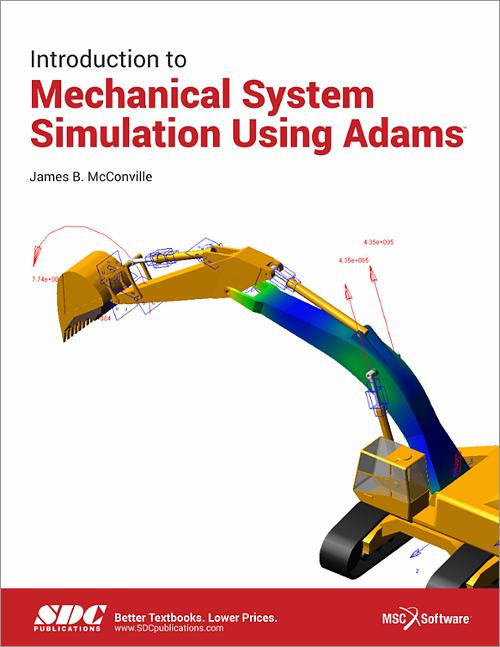Introduction to Mechanical System Simulation Using Adams
- Description
- Downloads
- More Info
- Details
Description
Key Features
- Developed for readers who have little or no experience with multibody dynamics
- Introduces you to the basics of how Adams models are formulated and then numerically solved
- Features relatively small examples that are easy to build and execute
- Provides a practical introduction to Adams that’s designed to complement the documentation
- Printed in full color
In Detail
This book is intended to familiarize you with the basics of theory and practice in Adams Multibody Dynamics (MBD) modeling. The content has been developed to be beneficial to readers who are students or practicing engineers who are either completely new to MBD modeling or have some experience with MBD modeling.
The author’s lengthy experience using the Adams software adds a practical and, occasionally, humorous complement to standard documentation and training materials, intended to benefit you while learning Adams.
The book features relatively small examples which you can readily build and execute. This book contains an introduction to Adams theory which provides the basics on how Adams models are formulated and then numerically solved. Finally, this book concludes with some success stories taken from industry.
About Adams
Adams helps engineers to study the dynamics of moving parts, as well as how loads and forces are distributed throughout mechanical systems. Adams improves engineering efficiency and reduces product development costs by enabling early system-level design validation. Engineers can evaluate and manage the complex interactions between disciplines including motion, structures, actuation, and controls to better optimize product designs for performance, safety, and comfort.
Multibody Dynamics (MBD) is characterized most of all by its ability to efficiently deal with appreciable motion. Such motion, and especially rotational motion, tends to be highly nonlinear in the spatial sense. Compounding this are effects which vary nonlinearly with time. Thus, all aspects of an MBD problem are usually mathematically very nonlinear. This is where Adams shines. It is specifically designed to deal efficiently with these nonlinearities.
Downloads
For additional information on downloading, unzipping, and using these files visit the downloads section on our FAQ page.
More Information
We recommend that you also download the Adams Tutorial Kit for Engineering Courses. The Adams tutorial package is designed as a supplemental curriculum kit for undergraduate Mechanical Engineering courses, including Design of Machinery, Dynamics, Mechanisms, and Mechanical Design.
There are 44 examples in the Adams tutorial package, including some simple problems like "four-bar linkage", "spring-damper system", and also some real industrial examples like "Open differential" or "Gear Train System", which are created based on a new powerful set of simulation modules in Adams called Adams/Machinery.
Go here to download: http://www.mscsoftware.com/page/adams-tutorial-kit-mechanical-engineering-courses
Product Details
| Publisher | SDC Publications |
| Authors | James B. McConville |
| Published | October 15, 2015 |
| User Level | Beginner - Intermediate |
| Pages | 152 |
| Binding | Paperback |
| Printing | Black and White |
| Print ISBN | 978-1-58503-988-3 |
| Print ISBN 10 | 1585039888 |
| eBook ISBN | 978-1-63056-276-2 |
